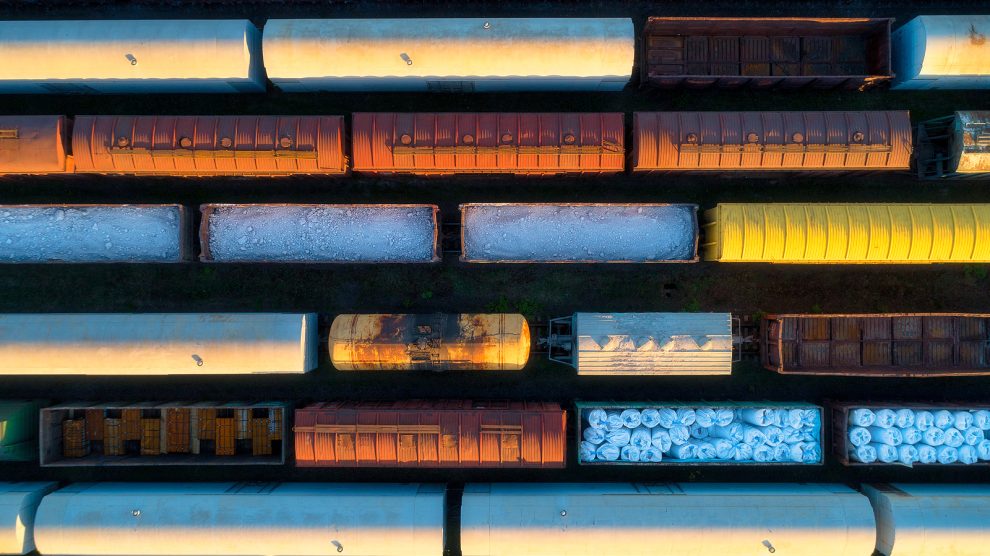A high-speed rail link across the continent could drive the shift of freight traffic from road to rail and provide major CO2 savings.
In a now widely-cited study, in 2018 the Vienna Institute for International Economic Studies (wiiw) proposed the construction of what it dubbed a ‘European Silk Road’.
The centrepiece of the proposal was a high-speed rail network that would connect the industrial centres of Western Europe with the less developed East of the continent. Complementing the feasibility study, at the beginning of 2022 wiiw also presented an analysis of the CO2 savings potential in passenger transport for the main route from Lyon to Moscow, which was still being considered at the time.
- Can the Three Seas Initiative be saved from irrelevance?
- Why Poland is key to improving Central and Eastern Europe’s railway connections
- Made in emerging Europe: Is a Polish start-up about to make maglev trains more accessible?
Now, an estimate of the CO2 savings potential for freight transport has also been elaborated. In view of the new geopolitical situation caused by Russia’s war on Ukraine, however, the main route analysed is the one from Lyon to Warsaw, as the war is likely to render the originally planned extension via Minsk to Moscow obsolete.
The new wiiw study concludes that a high-speed rail link from the Lyon to the Polish capital could reduce net CO2 emissions by around 176 million tonnes over a lifetime of 60 years for freight transport if trains ran at full capacity. This corresponds to a saving of about 24 per cent of the total emissions of the EU transport sector in one year (excluding air transport), based on 2018 figures.
This includes the emissions that would be generated during construction, operation and maintenance.
After 13 years of operation, the construction emissions would be offset. From that point on, the project would help to actually reduce CO2 emissions.
“If you consider that we are only talking about a single line with limited capacity, the CO2 savings potential would be considerable,” says Mario Holzner, co-author of the study and director of wiiw.
For comparison, 176 million tonnes of saved CO2 broadly correspond to the emissions of a major city with over one million inhabitants over 20 years, or the CO2 emissions of the Netherlands in 2021. If the greenhouse gases saved by passenger transport on this line are also taken into account, the CO2 savings potential should roughly double.
Together with co-authors Aleksandr Arsenev and Erica Angers, Holzner assumes that the construction of such a line would massively promote the shift of freight transport from road to rail.
“With good planning and cross-border co-ordination with the logistics industry, a high-speed rail link across the continent could be an enormous boost for more climate-friendly freight transport in Europe,” states Arsenev.
Construction costs are estimated at 164 billion euros at 2021 prices, or about one per cent of the EU’s economic output.
“Divided over a construction period of at least ten years and taking into account the positive economic effects, this sum, which seems considerable at first glance, is put into perspective,” Angers explains.
China at the gates
Moreover, according to the study’s authors, the ambitious project could also make a valuable contribution to shaping a green EU industrial policy to achieve the EU’s climate goals.
A high-speed rail link across the continent could also serve as an important extension of planned or already implemented rail routes in Europe. These include the projects envisaged by 13 Central and Eastern European EU members in the context of the Three Seas Initiative, the Rail Baltica route currently under construction, and the new Silk Road recently presented by the US and the EU at the G20 summit in India to connect India and the Middle East to Europe.
However, Holzner warns against seeing the new Silk Road only as a challenge to China’s Belt and Road Initiative, in which Beijing has invested heavily, especially in Eastern and Southeastern Europe.
“Ultimately, both ideas should complement each other and provide alternative ways to finance much needed transport infrastructure, as well as drive the expansion of existing connections for mutual economic benefit,” he concludes.
Unlike many news and information platforms, Emerging Europe is free to read, and always will be. There is no paywall here. We are independent, not affiliated with nor representing any political party or business organisation. We want the very best for emerging Europe, nothing more, nothing less. Your support will help us continue to spread the word about this amazing region.
You can contribute here. Thank you.



Add Comment